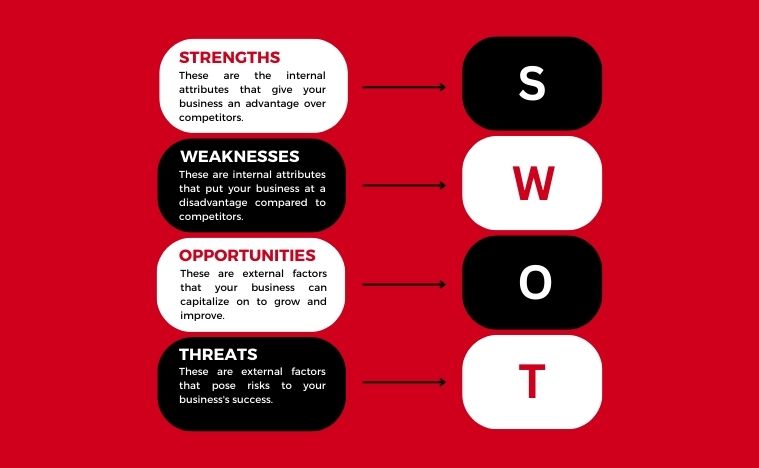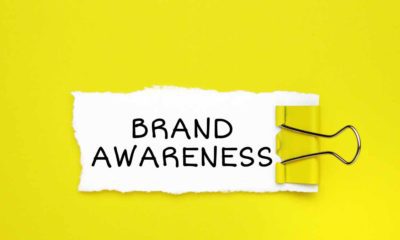Featured
SWOT Analysis: What Is It and How Does It Work
In today’s highly competitive business landscape, having a clear understanding of your company’s strengths and weaknesses, as well as identifying opportunities and threats, is crucial for success. One tool that has proven invaluable for businesses of all sizes is the SWOT analysis.
In this article, we will explore the concept of SWOT analysis, its elements, and how to conduct one effectively. Moreover, we will also discuss how to use the results to improve your business, common mistakes to avoid, and answer some frequently asked questions.
What is a SWOT Analysis
SWOT analysis is a strategic planning tool that helps businesses identify their internal strengths (S) and weaknesses (W), as well as external opportunities (O) and threats (T). The acronym SWOT stands for these four elements.
The purpose of a SWOT analysis is to provide a comprehensive overview of your business’s current position and to inform decision-making in areas such as marketing, operations, and finance.
The Elements of a SWOT Analysis
- Strengths (S): These are the internal attributes that give your business an advantage over competitors. Examples include experienced management, strong brand recognition, a loyal customer base, and efficient production processes.
- Weaknesses (W): These are internal attributes that put your business at a disadvantage compared to competitors. Examples include outdated technology, high employee turnover, poor location, and weak financial performance.
- Opportunities (O): These are external factors that your business can capitalize on to grow and improve. Examples include untapped markets, emerging trends, new technologies, and changes in customer preferences.
- Threats (T): These are external factors that pose risks to your business’s success. Examples include increased competition, economic downturns, regulatory changes, and supply chain disruptions.
How to Conduct a SWOT Analysis
- Assemble a diverse team: Include representatives from different departments and levels of your organization to ensure a comprehensive perspective.
- Set clear objectives: Identify the goals and objectives of the SWOT analysis, such as assessing a new product launch, entering a new market, or improving overall performance.
- Gather information: Collect data about your company’s strengths, weaknesses, opportunities, and threats through research, customer feedback, and employee input.
- Create a SWOT matrix: Divide a large piece of paper or whiteboard into four quadrants, labeled Strengths, Weaknesses, Opportunities, and Threats. List the relevant factors in each quadrant.
- Analyze and prioritize: Discuss and analyze the factors in each quadrant, prioritizing them based on their importance and potential impact on your business.
- Develop action plans: Create strategies to leverage strengths, address weaknesses, capitalize on opportunities, and mitigate threats.
[Read More] What Is Marketing Attribution? Your Must-Read Guide
Using SWOT Analysis To Improve Your Business
Now that you know how to conduct a SWOT analysis, it’s time to use it to improve your business. Here are a few ways you can use your SWOT analysis:
- Strategic planning: Use your SWOT analysis to develop a strategic plan for your business. Identify your goals and develop strategies to achieve them.
- Marketing: Use your SWOT analysis to develop a marketing plan that capitalizes on your strengths and addresses your weaknesses.
- Product development: Use your SWOT analysis to identify areas for improvement in your products or services.
- Risk management: Use your SWOT analysis to identify potential threats to your business and develop strategies to mitigate them.
Common Mistakes to Avoid When Conducting a SWOT Analysis
Conducting a SWOT analysis can be a valuable tool for any business owner looking to improve their company’s performance. However, there are some common mistakes that can derail the process and hinder its effectiveness.
Here are a few mistakes to avoid when conducting a SWOT analysis:
- Focusing too much on internal factors: While it’s important to assess your company’s internal strengths and weaknesses, it’s equally important to consider external factors that could impact your business. This includes analyzing industry trends, competitors, and market conditions.
- Being too vague: A SWOT analysis should be specific and focused on key areas of your business. Avoid using generalities or vague terms that don’t provide actionable insights.
- Neglecting to prioritize: Once you’ve identified your company’s strengths, weaknesses, opportunities, and threats, it’s important to prioritize them based on their potential impact on your business. As a result, failing to do so can result in a lack of direction and focus.
- Not involving stakeholders: Conducting a SWOT analysis in a vacuum can limit its effectiveness. Be sure to involve key stakeholders in the process, including employees, customers, and suppliers.
- Failing to take action: A SWOT analysis is only valuable if you use the insights gained to make improvements to your business. Failing to take action based on your findings can render the entire process useless.
[Read More] CRO Marketing 101: A Beginner’s Guide to Improving Conversion Rates
Bottom Line
A SWOT analysis is a powerful tool for assessing your company’s strengths, weaknesses, opportunities, and threats. By taking the time to conduct a thorough analysis, you can gain valuable insights into your business and develop strategies to improve performance. Though, it’s important to avoid common mistakes that can hinder the process and limit its effectiveness.
FAQs
1. How often should a SWOT analysis be conducted?
It’s recommended to conduct a SWOT analysis at least once a year or whenever there are major changes in your business or industry.
2. Can a SWOT analysis be conducted for personal use?
Yes, a SWOT analysis can be a useful tool for individuals looking to assess their personal strengths, weaknesses, opportunities, and threats.
3. What is the difference between a SWOT analysis and a PEST analysis?
While a SWOT analysis focuses on assessing internal strengths, weaknesses, opportunities, and threats, a PEST analysis examines external factors such as political, economic, social, and technological influences on a business.
4. Can a SWOT analysis be used for non-profit organizations or government agencies?
Yes, a SWOT analysis can be used by non-profit organizations and government agencies to assess their strengths, weaknesses, opportunities, and threats. It can help these organizations identify areas for improvement and develop strategies to better serve their constituents. However, it’s important to adapt the SWOT analysis to the unique needs and goals of these organizations.
Jonathan Phillip is an up and coming writer content creator with an interest in the stock market. He's found a powerful place in writing about true growth enterprises. Yet his primary focus for the last 7 years has been creating content about the cannabis industry and marijuana stocks. He is one of the top contributors to cannabis media outlets like MarijuanaStocks.com. He also in control of social media management for StockMarket.com. From a young age Jonathan has been an active fellow of the cannabis community. Born and raised in Miami, Florida, he's been able to recognize growing trends in the space including the start of cannabis derivatives, vapes, e-liquids, wax, and more. His capability to find emerging niches has given him the capacity to find valuable information from top industry names. Jonathan has also been able to build a strong social media presence for companies. He has worked with many public companies to develop a digital presence and footprint. As an active blogger and social media influencer, his focus is also on lifestyle segments of the market. You can find Jonathan documenting on topics ranging but not limited to industry conferences and investor events to corporate disclosures and cannabis market movers. From the start of marijuana companies going public, Jonathan has made it his mission to discover information before the crowd. The main focus point of his writing is on undiscovered or under-researched companies that could carry genuine, lasting market potential. Through his due dillagence process, Jonathan has worked to be one of the early writers to find the opportunity in cannabis over other things like alcohol and he was one of the inital content creators to cover the multi-billion dollar deals that occurred in 2017 and 2018. He has also covered the emergence of multi-state operators in the U.S. after Canada paved the way in late 2018 and 2019 for legalization in North America. Jonathan is also an active member of the underground hip-hop scene. He has worked with some of the biggest names in the rap community while also gaining valuable insight from top producers and business moguls focused on moving brands forward. In his free time, Jonathan builds social communities and continues to hone his skills as a leading financial writer.












